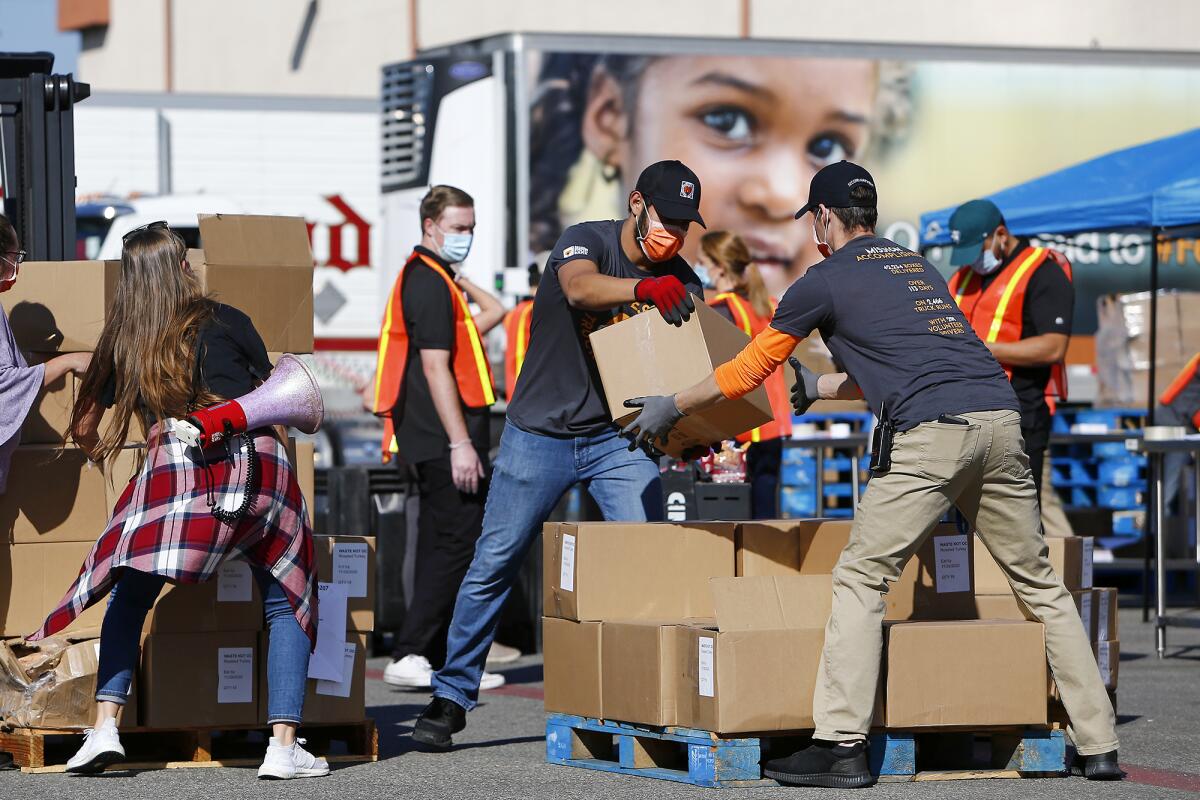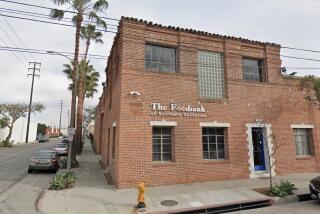As COVID-19 cases decrease, hunger still looms in Orange County

- Share via
Even as COVID-19 cases continue to decline in Orange County, a potential hunger crisis still looms.
The county’s two major food banks — Second Harvest and the O.C. Food Bank — are expecting to deliver millions of pounds of food this year, but they will need to raise millions of dollars to do it.
“We’ve still got a food marathon ahead,” said Harald Herrmann, chief executive of Second Harvest. “People are going back to work and vaccines are happening. There’s a general optimism and confidence that we’re starting to turn the corner. But there are still many people that have been economically impacted by COVID, and we’re going to be living with that for a while.
“There’s a lot of debt, there’s a lot of back rent, utilities, there’s lost income, lost savings. The need for a food bank and pantry network, not just in Orange County but really throughout the country in every market, will be very, very much needed, because there are many newly vulnerable families.”
Herrmann said they will need to raise $3.9 million in donations to meet the increased need. But if job numbers improve, they may need less.
The O.C. Food Bank, which is run by the Community Action Partnership of Orange County, projects that it will need to deliver 45 million pounds of food this year and will need $5 million in funding. CAP President and Chief Executive Gregory Scott said they delivered about 63 million pounds of food last year. The food bank delivered about 23 million pounds in 2019.
Scott said the group will get some of the funding from government contracts but will likely have to raise about $3 million.
“Recovery from COVID-19 is going to be long and hard for a lot of families, so even though we are getting less COVID cases, the unemployment rate is still 2½ times higher than it was a year ago,” he said. “And so along with that comes people taking on more debt or going deeper into debt.”
Unemployment could improve as vaccines continue to be administered and the economy opens back up. Orange County is now able to reopen gyms, movie theaters, museums and indoor dining at reduced capacities after entering the less-restrictive red tier of the state’s reopening system.
The county’s unemployment rate was at 7.4% in January, according to the most recently published numbers from the state’s Employment Development Department. The rate was 7.4% in December and 6.4% in November.
Herrmann said Second Harvest is moving about a million pounds of food a week. Before the pandemic, the nonprofit was delivering half that amount. Second Harvest delivered about 54.4-million pounds of food between March 2020 to January 2021, about an 82% increase in food served compared with 2019.
Scott said the O.C. Food Bank had several corporate sponsors and donors step up last year to provide donations. He’s hoping those sponsors return this year. Scott said 60% of the donors from last year were new. They’ll also use food drives and online donations.
Scott said there is a risk that the O.C. Food Bank can’t secure the necessary funding.
“Many corporate partners came out to help during COVID, and we have to count on those partners to duplicate what they did,” he said. “Some of them are in a position to do so, many of them can’t. And so, it is a risk. ... And then still shaking every tree and talking to the county about additional Cares Act funding to be able to supply more food is also on our strategy.”
Herrmann said his organization hopes to get grant funding. The nonprofit also takes online donations.
The food banks work with community organizations — churches, senior centers and schools, among others — to distribute food to 34 cities in the county.
But some of these smaller organizations were strained by the increased need. Herrmann said about 17% of Second Harvest’s partners remain closed.
“We’re just delivering that now to the partners that have been able to remain open, they’ve picked up the additional demand,” Herrmann said. “So still a full court press for the county.”
In November, Second Harvest, CAP and Waste Not O.C. formed the O.C. Hunger Alliance. Among other objectives, the partnership is meant to foster collaboration between the groups by leveraging purchasing power and strategizing distribution efforts.
Scott said it’s important for the food banks to work together to end hunger in the county.
“We are really strategizing around where we see the potential hunger gaps are — how are we distributing the food, how do we share resources and make sure we are able to get the food out to the right people,” Scott said. “We really show up together as collaborative planning partners to address the issue.”
Brazil writes for Times Community News.
More to Read
Sign up for Essential California
The most important California stories and recommendations in your inbox every morning.
You may occasionally receive promotional content from the Los Angeles Times.











